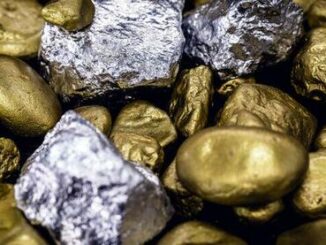
One month ago, we sparked a frenzy across precious metals circles when we reported that a “mystery” buyer had bought some 300 tons of gold, roughly three quarters of what would be a record 399 tons of central bank gold purchases in the third quarter.
Shortly after that, the mystery was solved as the PBOC officially reported an increase in its gold reserves for the first time in more than three years, confirming that the world’s most populous country was indeed the mystery buyer in the bullion market. The gold industry says Chinese buying is almost certainly higher.
Mark Bristow, chief executive of Barrick Gold, the world’s second-largest gold miner, said China had bought tonnes of gold around the high 200s mark, based on his discussions with numerous sources.
As we previously noted, there is definitely a bid below gold as if the historical relationship with real yields held, prices for the precious metal would be considerably lower (or perhaps it’s as simple as gold reflecting expectations of a dramatic easing of central bank policies at some point in the near future that the bankers themselves are loathed to admit)…
And now the mainstream media is recognizing the shift, as The FT reports today, central banks are scooping up gold at the fastest pace since 1967, with analysts pinning China and Russia as big buyers in an indication that some nations are keen to diversify their reserves away from the dollar.
The flight of central banks to gold “would suggest the geopolitical backdrop is one of mistrust, doubt and uncertainty” after the US and its allies froze Russia’s dollar reserves, said Adrian Ash, head of research at BullionVault, a gold marketplace.
Nicky Shiels, metals strategist at MKS PAMP, a precious metals trading company, says western nations’ actions (sanctions and frozen assets) have prompted nations outside the west to ask:
“Should we have exposure to so many dollars when the US and western governments can confiscate that at any time?”
Carsten Menke, head of next generation research at Julius Baer, reckons the purchases from Russia and China indicate a growing reluctance for countries to rely on the greenback.
“The message these central banks are sending by putting a larger share of their reserves in gold is that they don’t want to be reliant on the US dollar as their main reserve asset,” Menke said.
While central bank buying rarely drives sustainable gold rallies, it can provide an important pillar of support when prices fall. The precious metal has been under pressure this year from the Federal Reserve’s aggressive monetary tightening, though it has held up relatively well against moves in the dollar and Treasury yields.
“As deglobalisation accelerates, the non-G-10 nations are expected to ‘re-commoditize’ and ramp up gold holdings,” said Nicky Shiels.
Some in the industry speculate Middle Eastern governments are using fossil fuel export revenues to buy gold, most likely through sovereign wealth funds.
As Zoltan Pozsar wrote in a must-read note earlier this month, the role of gold may be changing as first Russia, then other countries (China) seek to force out the petrodollar and replace it with petrogold, a move which would finally lead to substantial price upside for the yellow metal which has gone nowhere in the past 2 years.
Zoltan is not alone as Saxo Bank’s Ole S. Hansen suggested in his outrageous projections this year that “2023 is the year that the market finally discovers that inflation is set to remain ablaze for the foreseeable future.”
In 2023, the hardest of currencies receives a further blast of support from three directions.
First, the geopolitical backdrop of an increasing war economy mentality of self reliance and minimizing holdings of foreign FX reserves, preferring gold.
Second, the massive investment in new national security priorities, including energy sources, the energy transition, and supply chains.
Third, rising global liquidity as policy makers move to avoid a debacle in debt markets as a mild real growth recession (certainly not in nominal prices, however!) takes hold.
Gold slices through the double top near USD 2,075 as if it wasn’t there and hurtles to at least USD 3,000 next year.
And finally, this is not a short-term move, as Bernard Dahdah, senior commodities analyst at Natixis, the French investment bank, said deglobalisation and geopolitical tensions meant the drive by central banks outside of the west to diversify away from the US dollar was “a trend that won’t change for a decade at least”.
Loading…



